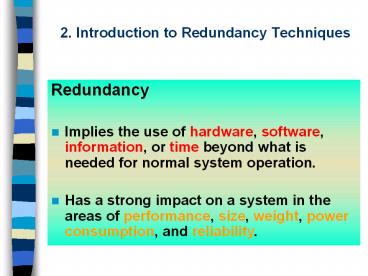2. Introduction to Redundancy Techniques - PowerPoint PPT Presentation
1 / 7
Title:
2. Introduction to Redundancy Techniques
Description:
Title: 1. Review of Multiprocessors and Fault Tolerance Author: Fabian Vargas Last modified by: Fabian Vargas Created Date: 6/2/2001 7:13:59 PM Document presentation ... – PowerPoint PPT presentation
Number of Views:93
Avg rating:3.0/5.0
Title: 2. Introduction to Redundancy Techniques
1
2. Introduction to Redundancy Techniques
- Redundancy
- Implies the use of hardware, software,
information, or time beyond what is needed for
normal system operation. - Has a strong impact on a system in the areas of
performance, size, weight, power consumption, and
reliability.
2
2. Introduction to Redundancy Techniques
- 2.1 Hardware Redundancy
- Passive
- ? Based on the concept of fault masking to hide
the occurrence of faults and prevent the faults
from resulting in errors (developed around the
concept of majority voting) - ? Do not provide for faults detection, but
simply mask them - Active, or Dynamic
- ? Attempts to achieve fault tolerance by means
of fault detection, fault location,
reconfiguration, and recovery (property of fault
masking is not obtained there is no attempt to
prevent faults from producing errors within the
system) - ? More suitable for applications where
temporary, erroneous results are acceptable, as
long as the system reconfigures and regains its
operational status in a satisfactory length of
time - Hybrid
- ? Combines the attractive features of both the
Active and the Passive approaches
3
2. Introduction to Redundancy Techniques
- 2.1 Hardware Redundancy
4
2. Introduction to Redundancy Techniques
- 2.1 Hardware Redundancy
- Voting at Several Levels within
- N-Modular Redundancy (NMR) Systems
- 3 independent temperature sensors perform a vote
on the 3 sensor values. Next, calculate the
amount of heat/cooling by means of 3 separate
modules, and then vote on the calculations to
determine a result. - X
- 3 independent sensors sample the temperature,
perform the calculations, and then provide a
single vote on the final result. - Difference between the two approaches ? fault
containment voting at the sensors will mask and
contain the effects of an eventual sensor fault.
5
2. Introduction to Redundancy Techniques
- 2.1 Hardware Redundancy
- HW Voting x SW Voting ?
- The availability of processor to perform the
voting - The speed at which voting must be performed
- The criticality of space, power, and weight
limitations - The of different voters that must be provided
- The flexibility required of the voter with
respect to future changes in the system
6
2. Introduction to Redundancy Techniques
- 2.1 Hardware Redundancy
- In practical applications of voting, 3 results in
a TMR system may not completely agree, even in a
fault-free environment - e.g., A/D converters in sensors may produce
quantities that disagree in the least-significant
bits. This disagreement can propagate into larger
discrepancies after computation, which can
significantly affect the voting process.
7
2. Introduction to Redundancy Techniques
- 2.1 Hardware Redundancy
- Solution ? Mid-Value select Technique
- A TMR system selects the value that lies in the
middle of the others

